The “Shark Cat” factory had expanded, and the boats had become very popular. What June and I wanted was just to become involved
in sailing boats, so we decided to start up on our own again.
I had designed a twenty eight footer, and started work on it under our house (see the RL28 story), but our main concern was some
suitable premises to start up in.
We approached the Department of Industrial Development in Brisbane and were put in touch with their local agent. Yes, he would be
able to help us! There was a factory that was becoming available in an Industrial estate in Southport. It would be available to
us on the condition that we double the building size within two years after which it would be available for purchase. The terms
and conditions were very reasonable, and we were given every assistance. I certainly had nothing but praise for the State Government
of the day.
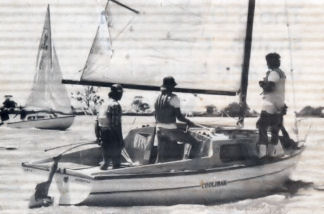 Coolibah
Coolibah (Barry Arnold) easily won the RL24 Nationals on
Lake Wellington, Vic.
A new face had emerged at RL24 events, it was Barry Arnold sailing Coolibah. We had sailed against Coolibah in the Tripoli’s
on the open Gulf waters in South Australia, but he hadn’t shown out, but at the National Championships on Lake Burrendong several
days later, Coolibah was unbeatable. Barry was a very clever helmsman on inland waters. He had an uncanny knack of finding
breeze and wind shifts around the lake. He always sailed with four crew and that seemed strange to me in the light conditions.
A year later at the next national series I had a plan. I was sure our boat was as fast as Coolibah so we would start the race
just to leeward and in clear wind, and let Coolibah lead us up the first beat. The plan worked well and we tacked every time
Coolibah tacked just holding our position about two boat lengths to leeward, and sure enough, we were soon well clear of the rest
of the fleet. He had picked every lift before it arrived. When I thought we could lay the weather mark we tacked, but soon fell away
and had to tack again, only to find Coolibah well ahead, and he stayed that way until the end of the race. Barry was the National
Champion for several years until another owner with an entirely different approach would have a lasting influence on the class.
Brisbane and the Gold Coast had been affected badly by floods from a cyclone, and one evening I was called to the telephone.
A voice said, “You and your bloody boats. Look what you’ve gone and done”.
I had no idea what I’d done ! The voice continued, “Now my garage’s gone too.” It turned out, that the gentleman’s house was
on the banks of the upper Brisbane river, and his RL24 was housed on its trailer in a garage next to the house. The flood had risen,
and the boat, still tied down on its trailer, had floated off down the river with the garage on top. It eventually came up
alongside a bridge, and the battered garage drifted off in bits, but the boat with the trailer still attached was rescued by the
water police undamaged.
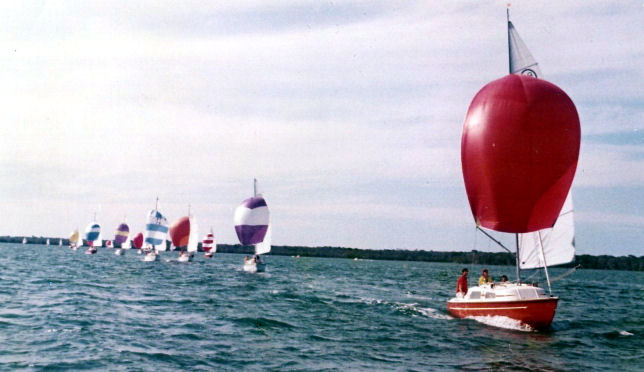
Harold Peacock leads the fleet of 30 home, in Southern Cross during the long distance race, at the second National Titles held
at Southport. At this series a boat was trailed all the way from Port Headland,in W.A. They came over via the northern route,
and went
home via the Nullarbor, a round trip distance of approximately 12,000 Km.
|
Peter Yeomans was full of ideas when he ordered his first boat Lorna Dee, he fitted his boat with a “Hobie Cat” rig, the first
RL 24 with a fully battened mainsail.
When the boats first became a class, I was determined that any sensible improvements should be allowed within the rules, provided
that the mast height was limited, and the sail area did not exceed 20 square metres.
I had found that strictly one design classes eventually became boring and frustrating knowing that something was wrong, but not
being allowed fix it. No designer can ever design a perfect boat straight off his drawing board; room should always be left for
improvements!
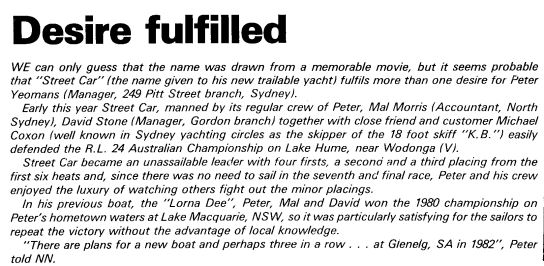
This write up along with the photo was published in the National Bank’s magazine.
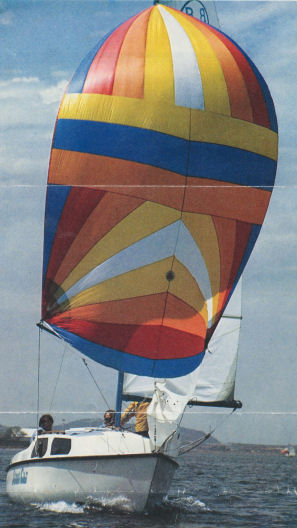 Lorna Dee
Lorna Dee was the first of Peter Yeomans three development
boats, and he was largely responsible for the development
of the drop keel Mk111
A boat building company in the USA wrote enquiring about building the RL24 over there, under license. We responded that yes we
would be interested but would like to meet one of the principles in person to talk over the details. Duly, Bob White flew over
to discuss the details, and we came to a mutually satisfactory agreement.
The boats were to be built in Minnesota, and distributed in all states by local dealers.
There is always a catch! Firstly we had to find a solicitor who had skills in International agreements, and then when both parties
were satisfied the Reserve bank of Australia had to ratify it. This took three months.
We were finally able to mould a hull, deck and interior, and along with other patterns and samples ship them over to Seattle. They
were then trucked on to Minnesota.
A month after the parts were delivered, I enquired as to how everything was going together, and was amazed when told that fifty had
been sold,
How could this happen so quickly? The answer came, “Oh we set up an office and employed two salesmen, and we now have a distributor
in each State.” No boats had been built yet, but fifty were sold. We felt that this was a strange way of doing things!
It was arranged that June and I would fly over when the first boats were under way, and help out with any small problems that may
arise.
When we were notified that production had started we made the trip to Minneapolis, and were taken to a huge factory some sixty miles
north of the city. I hadn’t understood that the mouldings were to be done by an outside company, and was concerned that they may not
know what they were doing.
I spoke to the manager, and was told that the company did contract mouldings. They currently had orders for some eighty thousand
stadium seats, and were making the bodies for thirty “Bell service trucks” but boats were something new for them.
Every moulded part was made up from computer cut matt, and the staff working on some of the RL24 components didn’t even realise
that they were working on a sailing boat.
We never did get to see a boat being put together, but we were assured that everything would turn out OK.
We eventually did get some royalties, but it wasn’t long before the company was in trouble, and we never did get to know exactly
how many boats had been built. We were led to understand that the company was taken over by a business that imported yachts from
France, and that the RL moulds were somewhere stored away in a warehouse.
Our legal advice was to forget it; there was no future in chasing it up!
No regrets; we live and learn, and I hope that those in the USA, that got their boats do enjoy them.
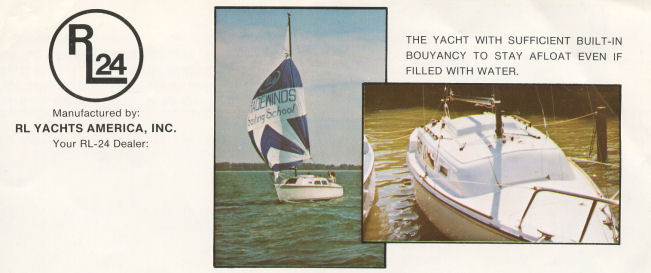
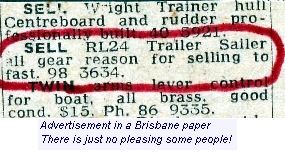
Go back to Previous Episode | Go back to Index | Go on to Next Episode